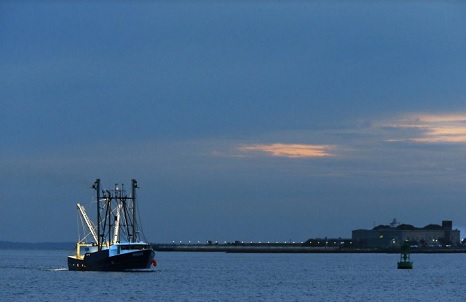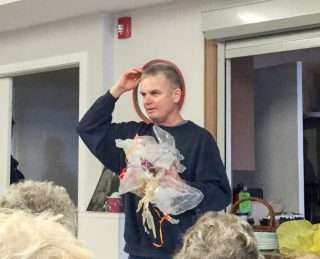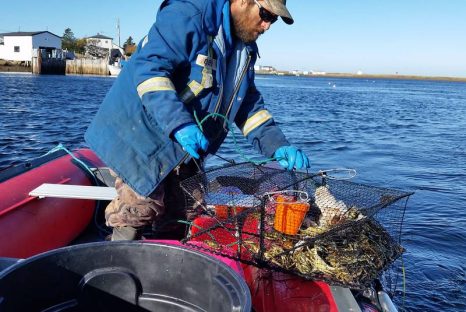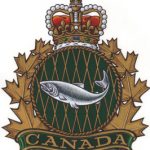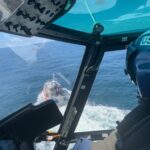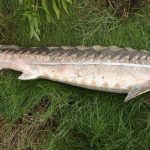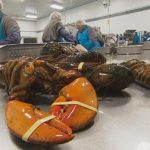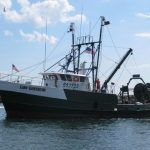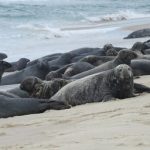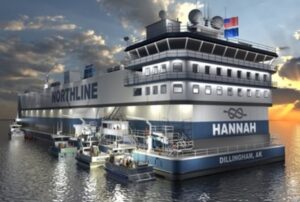Tag Archives: scallops
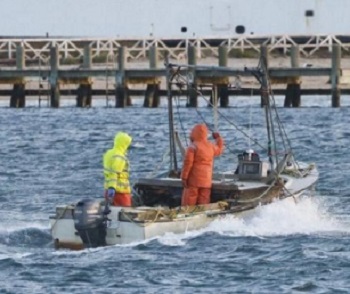
Scallops open at $16-$22 a pound
Nantucket’s commercial scalloping season opened Monday morning with a fleet of about 16 fishermen heading into Nantucket and Madaket harbors at low tide with gusty winds of 25-30 mph. The scallopers were bringing their catch to island fish markets by 2 p.m., which were charging customers $16-22 per pound for shucked scallop meat, compared to $25-26 on opening day last year. Ninety-six island fishermen took out commercial scalloping licenses this year, according to town natural resources coordinator Joanne Dodd. There were 108 commercial licenses issued last year, and 79 the year before. >click to read< 11:13
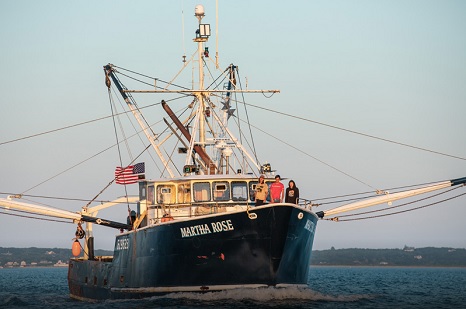
The F/V Martha Rose: her catch, crew, and mission – As Fresh as it Gets
Three times a week, the Martha Rose sets out of Menemsha’s cozy harbor and, engine roaring, begins the 14-hour journey to the local scalloping beds. In weather fair or foul, the 77-foot fishing vessel chugs out of Menemsha Bight, rounds the nose of Aquinnah, and then charts a steady course to the southeast. The sea scallop beds currently designated as fishable lie one hundred miles out, and some thirty or forty fathoms down. Once the Martha Rose arrives, her crew of three waste no time putting out the ship’s dredge and preparing the deck to bring in the first haul. photos, >click to read< 09:26
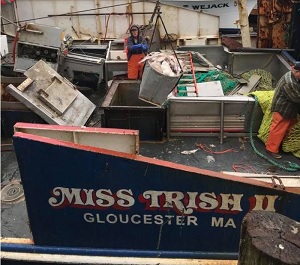
Providing seafood to the public in Gloucester: Drive-Thru “Pop-Up” Event-Tuesday 3/31/20
We at Fisherman’s Wharf Gloucester were so overwhelmed with the unexpected turnout from Saturday’s event. We want to continue to provide seafood to the public. We’re stocking up on Fresh Haddock right off F/V Miss Trish II and Scallops from our local day boats. Thank you for your support of our local business, and we look forward to seeing you at Tuesday’s event. Scallop and Haddock Drive-Thru “Pop-Up” Event, Tuesday March 31st Starting at 12:00 pm-5pm 37 Rogers Street, Gloucester, MA details, photos, >click to read< 10:01
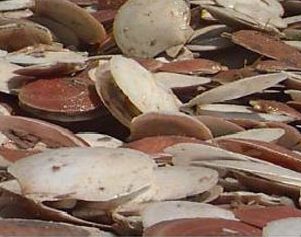
The Seagan Movement: Are Scallops Actually Vegan?
When it comes to bivalves, the line between plant and animal is unclear. The rules of veganism, at first glance, seem pretty clear. Vegans don’t consume any food derived from animals.,, Now, to complicate matters further, there’s an entire movement dedicated to seagan eating, which argues that seafood truly belongs in a vegan diet.,, “Eating products from well-managed fisheries benefits the environment in many ways,” explains Togue Brawn of Maine-based scallop supplier Downeast Dayboat. >click to read< 07:41
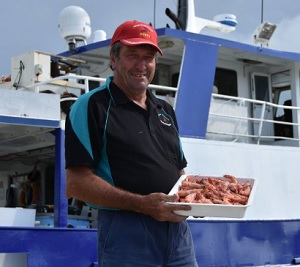
The Best North Queensland seafood available for Christmas
Fishers are encouraging families to include wild caught Australian seafood in their festive feast in a bid to prop up the industry amid regulatory green-tape.,,, “There is that much pressure on the fishing industry, that for some the future is looking pretty bleak,” Mr Dansie said. “The biggest things is that if people want to have real Australian seafood they need to keep buying and supporting us.” >click to read< Support your fishing industry! 15:34
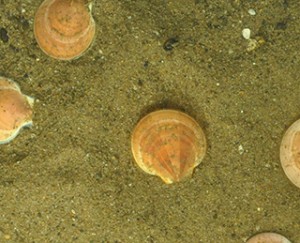
Federal Fishing Expansion Could Endanger Right Whales
Trump regulators opened about 3,100 square miles of ocean to fishing for scallops and fish that live near the bottom of the ocean such as halibut and flounder that had been closed for more than two decades, including a section of Georges Bank off Cape Cod, Mass., and part of the ocean near southern New England.,, A scallop fishing industry group, Fisheries Survival Fund, said no scallop vessel has ever had an interaction with a right whale. >click to read< 11:29
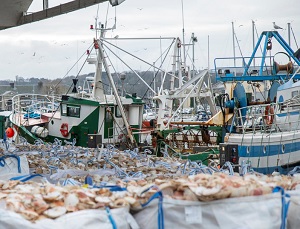
Fines to rogue fishermen fall and illegal fishing escapes prosecution, environmentalists claim
Concerns have been raised recently that fishermen are increasingly involved in illegal scallop dredging and prawn trawling to supply a black market in seafood, at the expense of Scotland’s marine environment.,,, Environmentalists claim that the Scottish Government is not treating damage to MPAs by boats as “serious crimes”. They have accused the official body tasked with protecting seas, Marine Scotland, of failing to take tough enforcement action against skippers breaking the law. >click to read< 13:54
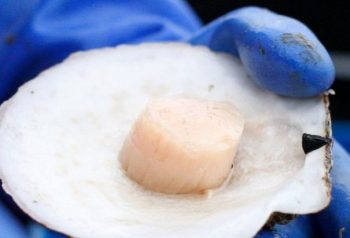
America’s got scallops: Catch is up, consumers shelling out
America’s harvest of scallops is increasing to near-record levels at a time when the shellfish are in high demand and the value of the fishery has surged in recent years. Sea scallops, harvested mostly by boats from the cold Atlantic Ocean, are the target of one of the most valuable fisheries in America. New data from the National Oceanic and Atmospheric Administration says the harvest topped 58.2 million pounds last year, the highest total since 2011 and the fifth-highest in history according to federal statistics going back to 1945. >click to read< 15:30
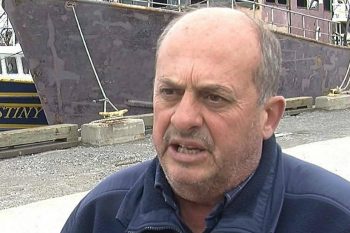
What About Carlos Rafael, His Permits and His Boats? [OPINION]
There has been little public talk about “The Codfather” and his fishing empire since he was sentenced to federal prison for crimes related to fishing. In September of 2017, Judge William Young sentenced Carlos “The Codfather” Rafael to 46 months in federal prison. Additionally, Judge Young fined him $200,000 and three years supervised probation after his release from prison.,,, hearing rumors that two big players have emerged as the buyers of the boats and the all-important federal permits. One buyer wants the groundfish operation and one wants the scallop operation. There is concern locally that “Wall Street money” is coming in to buy up the local operations. >click to read<08:21
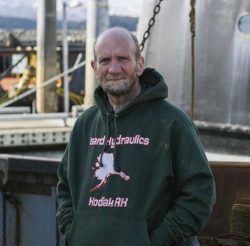
Kodiak man dives into scallop fishery – has been fishing scallops out of Kodiak for 40 years
With regards to scallops, Tom Minio could accurately be described as erudite. On Thursday afternoon, Minio sat in the galley of his vessel, the Provider, explaining what makes the best product, while the metallic screeches of boat work drifted in from other parts of the vessel. “The market really loves the big stuff, which I don’t understand. I don’t like eating big scallops,” he said. “It’s just like old halibut, you know: the bigger they are, the older they are and the tougher they are.” Minio has been fishing scallops out of Kodiak for 40 years. He started when he was 18 years old and doesn’t know anyone who’s been doing it longer than he has. With a small number of limited entry permits available and the quota around Kodiak decreasing, other fishermen and vessels dropped out of the fishery — but Minio held on. During the most recent season, the Provider was the only vessel fishing scallops in the Kodiak fishery. >click to read<14:01

‘White gold’ on deck of French trawler signals bumper haul of scallops
On the trawler Thierisa the mood was festive. It was the first day of the scallop season and the deck already groaned with the “white gold” of a bumper season in the waters off northern France. After two and a half hours on turbulent waters, they arrived at the fishing grounds but had to wait until noon and the start of the scallop season at Bay of the Seine. Police helicopters hovered to make sure no nets were lowered early. Northern France’s season for scallop, or “white gold”, runs from October to mid-May but in Bay of the Seine it starts in November. click here to read the story 12:17
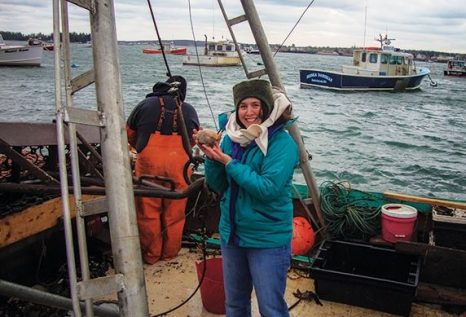
Maine: Plenty of scallops, but prices are low
The price for scallops so far this season is considerably lower than last year. The Ellsworth American reported that with the start of the scallop season on Dec. 1 the price per pound is down $2 to $3 from 2016’s average of $12.77. It also appeared that scallops were plentiful, but small, which generally means lower prices. “I’ve heard the price is going to be low this year, but a lot of dealers were quoting prices last week that I thought were absurd,” Togue Brawn, owner of Downeast Dayboat Scallops in Portland, told the newspaper. click here to read the story 11:25
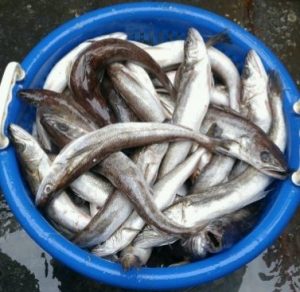
NEFMC: Scallops, Council Approves Framework 29 – Whiting, Approves 2018-2020 Specifics; to Send Amendment 22 to Public Hearing
The Council took two actions today related to small-mesh multispecies, which include two stocks of silver hake and offshore hake –collectively known as “whiting” –and two stocks of red hake. click here to read the notice 16:37
The Council today approved a sweeping package of measures for Framework Adjustment 29 to the Atlantic Sea Scallop Fishery Management Plan. The framework includes specifications for the 2018 scallop fishing year, which begins April 1, as well as default specifications for 2019. It also includes actions related to Closed Area 1 carryover pounds, the Northern Gulf of Maine Management Area, and flatfish accountability measures, among others. click here to read the notice
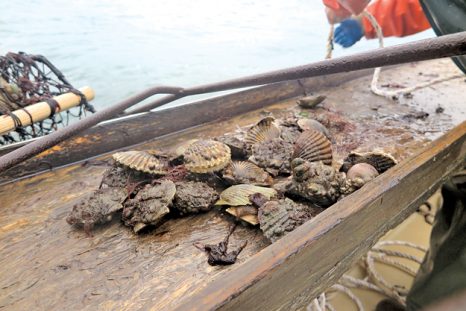
Rescuing a regional treasure: Biologists, baymen bringing back Peconic Bay scallops
Last week the veil was lifted on a question at the center of the East End’s culture as well as its economy: How many Peconic Bay scallops made it through algae blooms, whelk attacks, underwater landslides and onto dinner tables this season? Sunrise on Monday, November 6 marked the opening of New York State waters for fishing this sweet local delicacy, and by 7 a.m. it was clear there were plenty of scallops to be harvested. There are many ways for a scallop to die before its time, and Long Island University biologist Stephen Tettelbach, is familiar with all of them. click here to read the story 13:34
New England, Mid-Atlantic States Lead Nation in Volume and Value of Several Key Fisheries
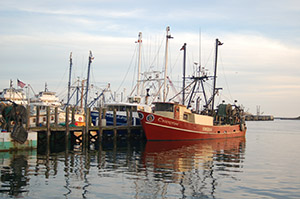 NOAA Fisheries has released the Fisheries of the U. S. 2016 report, and once again New Bedford, Mass. was the leading U.S. port by value and American lobsters were the nation’s most valuable landed species. Alaska led all states in the value and volume of commercial landings, with 5.6 billion pounds valued at $1.6 billion. Maine and Massachusetts ranked second and third in the value of landings at $633.6 million and $552.1 million, respectively. American lobsters were the nation’s top-valued species landed, with crabs second and scallops third. Alaska pollock ranked first in volume of landings, followed by menhaden and Pacific cod. click here to read the story 17:39
NOAA Fisheries has released the Fisheries of the U. S. 2016 report, and once again New Bedford, Mass. was the leading U.S. port by value and American lobsters were the nation’s most valuable landed species. Alaska led all states in the value and volume of commercial landings, with 5.6 billion pounds valued at $1.6 billion. Maine and Massachusetts ranked second and third in the value of landings at $633.6 million and $552.1 million, respectively. American lobsters were the nation’s top-valued species landed, with crabs second and scallops third. Alaska pollock ranked first in volume of landings, followed by menhaden and Pacific cod. click here to read the story 17:39
Hybrid green crab species threatens N.L. lobster – also eat clams, scallops and even each other
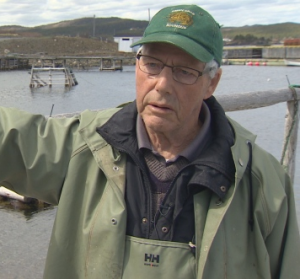 They’re fearless. They can live for weeks out of the water. They will eat anything, even each other. “They were born ferocious,” said Cynthia McKenzie, a scientist with the Department of Fisheries and Oceans based in St. John’s. McKenzie is one of a group of researchers who have identified a species of green crab that is ravaging parts of Newfoundland’s south coast. Fishermen in Placentia Bay, on the southeast coast, first noticed green crab in 2007. “When a lobster spawns … the green crab is there to eat it,” said Clarence Marsh. “I think the green crab got a big effect on the lobsters, and that’s why there’s none here in this bay now.” The green crab are “numerous,” said Marsh, and they don’t stop at eating lobster. He has also found tiny green crabs inside scallop shells. Click here to read the story 10:42
They’re fearless. They can live for weeks out of the water. They will eat anything, even each other. “They were born ferocious,” said Cynthia McKenzie, a scientist with the Department of Fisheries and Oceans based in St. John’s. McKenzie is one of a group of researchers who have identified a species of green crab that is ravaging parts of Newfoundland’s south coast. Fishermen in Placentia Bay, on the southeast coast, first noticed green crab in 2007. “When a lobster spawns … the green crab is there to eat it,” said Clarence Marsh. “I think the green crab got a big effect on the lobsters, and that’s why there’s none here in this bay now.” The green crab are “numerous,” said Marsh, and they don’t stop at eating lobster. He has also found tiny green crabs inside scallop shells. Click here to read the story 10:42
Can scallops be farmed in Penobscot Bay?
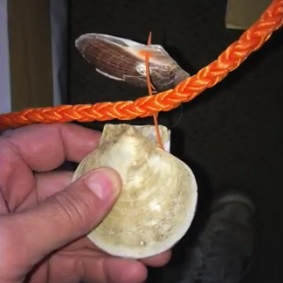 Everybody knows that the waters off Stonington are a rich source of wild scallops. Could they also be a good place to farm them? Robert Brewer of Deer Isle hopes to find out. Brewer recently applied to the for a 3.8-acre experimental aquaculture lease in East Penobscot Bay, where he plans to grow scallops on suspended ropes using the ear-hanging method developed in Japan. The technique calls for drilling a tiny hole through the flat “ear” at the base of the scallop shell and inserting a plastic pin with a small line attached. The scallops are hung in pairs along ropes called “droppers” that hang vertically beneath the surface.,,, DMR has opened a 30-day comment period for Brewer’s application. Click here to read the story 13:12
Everybody knows that the waters off Stonington are a rich source of wild scallops. Could they also be a good place to farm them? Robert Brewer of Deer Isle hopes to find out. Brewer recently applied to the for a 3.8-acre experimental aquaculture lease in East Penobscot Bay, where he plans to grow scallops on suspended ropes using the ear-hanging method developed in Japan. The technique calls for drilling a tiny hole through the flat “ear” at the base of the scallop shell and inserting a plastic pin with a small line attached. The scallops are hung in pairs along ropes called “droppers” that hang vertically beneath the surface.,,, DMR has opened a 30-day comment period for Brewer’s application. Click here to read the story 13:12
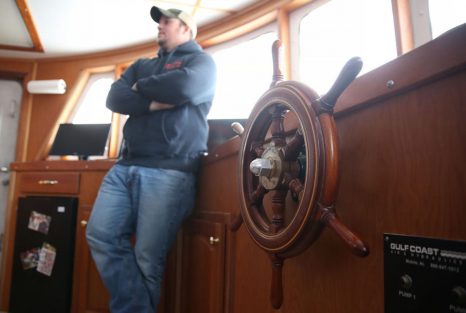
Cape May fishermen chase scallops despite risks, trade-offs
Scallops caught by boats based in southern Cape May County may end up on your plate at a local restaurant, or in the frozen foods section of a Wal-Mart or Costco, or even in foreign countries like France. But before the delicious white mollusks end up frozen in a chain store or fresh at a restaurant, commercial fishermen have to scrape them from the bottom of the ocean floor. It’s a fairly lucrative business that fuels a commercial fishing industry worth tens of millions of dollars each year. But the job takes an emotional toll on the fishermen who must leave their families for up to two weeks at a time to go to sea. Tom McNulty Jr.’s wife, Mandy, gave birth Feb. 16 to a daughter. Zoe McNulty was born at 7 pounds, 12 ounces, the proud father announced recently. But with scallop season quickly approaching, he’s going to have to leave them to go make a living.,, “It’s hard on your family,” he added. “You miss birthdays. You miss graduations.” Photo gallery, continue reading the article here 10:17
Scallops scuffle pitting small boats against big
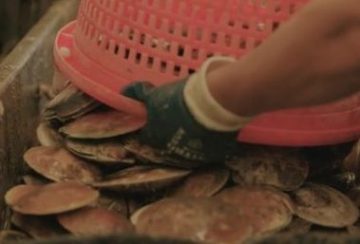 A disagreement over the right to fish for scallops off New England is pitting small boats against big ones in one of the most lucrative fisheries in the U.S. The federal government maintains different rules for the small- and big-boat scallop fisheries, though they work some of the same areas. Small boat fishermen say the conflict has arisen in the northern Gulf of Maine, a critically important fishing area stretching roughly from Boston to the border of Maine and Canada. At issue is the fact that the northern Gulf of Maine is fertile ground for scallops right now, and rules allow the bigger boats to harvest more of them. The smaller boats have a possession limit of 200 pounds, while the largest boats have no such limit, because they are regulated instead by a limited number of days at sea. Continue reading the article here 11:48
A disagreement over the right to fish for scallops off New England is pitting small boats against big ones in one of the most lucrative fisheries in the U.S. The federal government maintains different rules for the small- and big-boat scallop fisheries, though they work some of the same areas. Small boat fishermen say the conflict has arisen in the northern Gulf of Maine, a critically important fishing area stretching roughly from Boston to the border of Maine and Canada. At issue is the fact that the northern Gulf of Maine is fertile ground for scallops right now, and rules allow the bigger boats to harvest more of them. The smaller boats have a possession limit of 200 pounds, while the largest boats have no such limit, because they are regulated instead by a limited number of days at sea. Continue reading the article here 11:48

The shortest route between Maine and Japan: scallops
Last month, lobstermen Marsden Brewer and his son, Bobby, joined a delegation of Maine fishermen and aquaculturists on a visit to Aomori on the northern coast of Japan’s major island to learn about the latest techniques for cultivating scallops. Among their hosts was Hiroaki Sugiyama, an inventor and manufacturer of high-tech machinery used in Japan’s enormous scallop aquaculture industry. On Monday, the Brewers returned the favor. Sugiyama arrived in the U.S. Sunday night for a four-day visit to learn about what is happening in Maine’s nascent scallop aquaculture industry. After a stop at a newly-formed aquaculture cooperative in Spruce Head, and a boat ride to visit an experimental scallop growing operation, Sugiyama and his Maine hosts traveled to Stonington for more talk about scallop aquaculture, and a terrific lunch, hosted by Marsden and Donna Brewer at their Red Barn Farm. Read the article here 18:54
Construction of subsea power cable for Cutler Naval Communications Station has Scallopers concerned
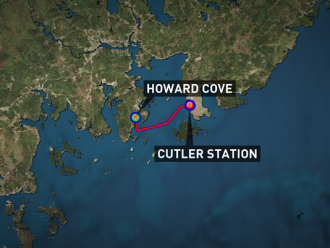 Fishermen in Machias Bay are on alert as the construction of a subsea power cable is set to get underway. Some met with representatives from the Navy and firms involved in the project in East Machias Monday night to clarify the final plan. “We’ve been in contact with the fishing community starting and throughout the design and environmental review process—so prior to the award of the project,” Kari Moore an environmental planner with the Navy said. Fishermen are worried about how the cable will be classified. They fear it will restrict fishing in parts of the bay. Their primary concern: dredging for scallops in a prime location. “If it gets classified a certain way as a cable area itself, we will lose a lot of bottom, but it’s not a safety concern where it’s buried,” said fisherman Michael E. Murphy. Video, read the story here 14:53
Fishermen in Machias Bay are on alert as the construction of a subsea power cable is set to get underway. Some met with representatives from the Navy and firms involved in the project in East Machias Monday night to clarify the final plan. “We’ve been in contact with the fishing community starting and throughout the design and environmental review process—so prior to the award of the project,” Kari Moore an environmental planner with the Navy said. Fishermen are worried about how the cable will be classified. They fear it will restrict fishing in parts of the bay. Their primary concern: dredging for scallops in a prime location. “If it gets classified a certain way as a cable area itself, we will lose a lot of bottom, but it’s not a safety concern where it’s buried,” said fisherman Michael E. Murphy. Video, read the story here 14:53
Small Boat Fishermen Worry New Rules Won’t Come in Time to Save N. Atlantic Scallops
 A quandary over scallop rules has two groups of fishermen in Maine at odds over the increasingly lucrative shellfish. Kristan Porter, is an independent fisherman who catches lobsters for most of the year with his boat “Brandon Jay.” But for additional income, for five months each year, he and the two other men on his boat have begun collecting scallops. Eric Hansen, of New Bedford, Massachusetts, is one of the permit holders that aren’t bound by the same quota that Porter and others follow. Hansen, who typically fishes south of Maine, returned to the Gulf of Maine this year for the first time in decades. His family business obtained one of the permits back in 1994 for free that now could be sold for millions of dollars. Read the rest here 08:41
A quandary over scallop rules has two groups of fishermen in Maine at odds over the increasingly lucrative shellfish. Kristan Porter, is an independent fisherman who catches lobsters for most of the year with his boat “Brandon Jay.” But for additional income, for five months each year, he and the two other men on his boat have begun collecting scallops. Eric Hansen, of New Bedford, Massachusetts, is one of the permit holders that aren’t bound by the same quota that Porter and others follow. Hansen, who typically fishes south of Maine, returned to the Gulf of Maine this year for the first time in decades. His family business obtained one of the permits back in 1994 for free that now could be sold for millions of dollars. Read the rest here 08:41
Squeezed Scallops Land High Prices
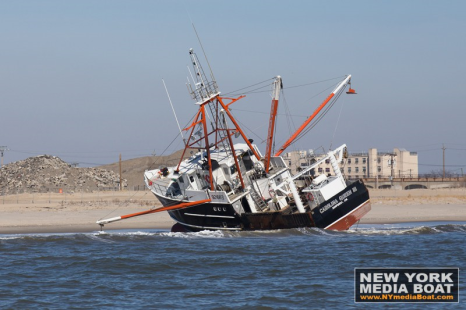 With her shrimp-colored outriggers and a home port of Seaford, Va., it wasn’t hard to wonder what a boat like Carolina Queen III was doing so far up north when she ran aground in a storm near Rockaway Inlet on Long Island last week. Turns out she was chasing the nation’s most lucrative fishery: sea scallops, which, in 2014, amounted to a $400 million market. “It’s a pretty mobile fleet,” said Deirdre Boelke, the sea scallop fishery analyst for the New England Fishery Management Council, explaining that the fishery spans an area from North Carolina to Maine, and that scallops prefer a depth of about 50 meters, or 150 feet. Read the rest here 07:43
With her shrimp-colored outriggers and a home port of Seaford, Va., it wasn’t hard to wonder what a boat like Carolina Queen III was doing so far up north when she ran aground in a storm near Rockaway Inlet on Long Island last week. Turns out she was chasing the nation’s most lucrative fishery: sea scallops, which, in 2014, amounted to a $400 million market. “It’s a pretty mobile fleet,” said Deirdre Boelke, the sea scallop fishery analyst for the New England Fishery Management Council, explaining that the fishery spans an area from North Carolina to Maine, and that scallops prefer a depth of about 50 meters, or 150 feet. Read the rest here 07:43
Oak Bluffs shellfish constable says seed scallop must be protected
 Mr. Grunden first announced the closure at the selectmen’s meeting on Oct. 13. “It was a very difficult decision,” he told The Times on Monday. “A lot of factors had to be considered, including a few people’s wages. But there is a very high percentage of seed in the pond.” Mr. Grunden said it was the first time he has closed Sengie to scalloping in his 16 years on the job. And the closure was not well received. Read the article here 17:16
Mr. Grunden first announced the closure at the selectmen’s meeting on Oct. 13. “It was a very difficult decision,” he told The Times on Monday. “A lot of factors had to be considered, including a few people’s wages. But there is a very high percentage of seed in the pond.” Mr. Grunden said it was the first time he has closed Sengie to scalloping in his 16 years on the job. And the closure was not well received. Read the article here 17:16
How to Sear Scallops
 I’d been cooking scallops for years in restaurant kitchens with no problems. How different could it be at home? Quite different, apparently. The problem came down to two things: using the wrong scallops and mismanaging moisture. Let me give you some details so that you (and your date!) won’t suffer the same fate. Wet and Dry scallops. The first problem with scallops occurs before you even buy them. Read the rest here, and enjoy your dinner! 14:38
I’d been cooking scallops for years in restaurant kitchens with no problems. How different could it be at home? Quite different, apparently. The problem came down to two things: using the wrong scallops and mismanaging moisture. Let me give you some details so that you (and your date!) won’t suffer the same fate. Wet and Dry scallops. The first problem with scallops occurs before you even buy them. Read the rest here, and enjoy your dinner! 14:38
New Bedford top port again thanks to scallops
New Bedford was the  in 2013, landing $379 million worth of seafood, according to a new report. The finding by Icelandic Bank Research marks the 15th consecutive year the city has been the nation’s most prosperous port, even as the total volume of fish harvested statewide has declined. Local fishermen and officials say the reason for New Bedford’s success is due largely to scallops, the state’s most valuable species. Read the rest here 15:19
in 2013, landing $379 million worth of seafood, according to a new report. The finding by Icelandic Bank Research marks the 15th consecutive year the city has been the nation’s most prosperous port, even as the total volume of fish harvested statewide has declined. Local fishermen and officials say the reason for New Bedford’s success is due largely to scallops, the state’s most valuable species. Read the rest here 15:19






